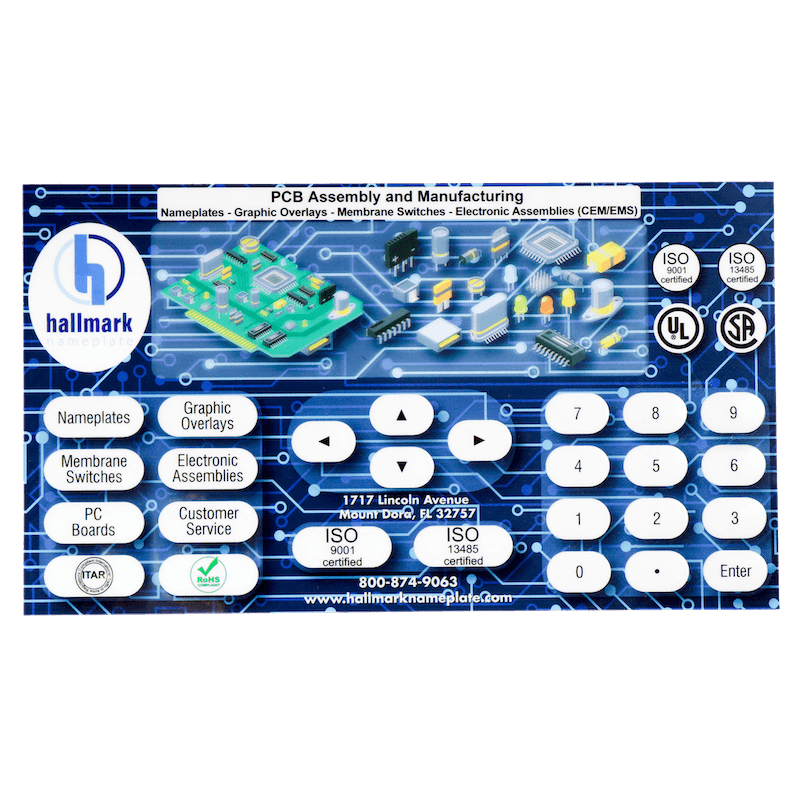Comprehending Membrane Changes: The Trick to Resilient and Reliable Controls

What Are Membrane Switches?
Membrane switches are an advanced solution in the world of interface technology, incorporating capability and layout seamlessly. These devices function as a user interface in between customers and digital systems, incorporating a number of elements into a small style. Commonly created from adaptable, slim layers of materials, membrane switches are developed to respond to touch, enabling users to interact with equipment and digital tools properly.
The key aspects of a membrane button consist of a published circuit layer, visuals overlay, and a spacer layer that avoids unintentional activation. The graphic overlay can be customized to reflect brand identity or user choices, boosting appearances while ensuring usability. Membrane layer buttons are frequently used in various applications, consisting of medical devices, customer electronics, and industrial tools, owing to their toughness and resistance to ecological variables such as wetness and dust.
Among the crucial advantages of membrane layer switches is their capability to endure wear and tear, making them ideal for high-traffic settings. Additionally, they are lightweight and require minimal area, permitting cutting-edge styles in item development. On the whole, membrane switches over represent a efficient and useful choice for contemporary electronic interfaces, weding innovation with user-centric style principles.
Exactly How Membrane Layer Changes Job
The operation of membrane layer switches rest on a straightforward yet reliable mechanism that converts user input right into electronic signals. These buttons contain numerous layers, typically including a graphic overlay, a spacer layer, and a circuit layer. When an individual presses the switch, the top layer warps, permitting a conductive aspect in the circuit layer to reach a corresponding conductive pad on the bottom of the graphic overlay. This call closes the circuit and sends out a digital signal to the gadget, showing that the button has been triggered.
The layout of membrane buttons can vary, yet they often include domes or responsive components to provide responses to the user, boosting the general experience - membrane switch. The materials utilized in membrane buttons, such as polyester or polycarbonate, add to their resilience and resistance to environmental elements, including dampness and dust. The published circuits are generally encapsulated, which safeguards them from wear investigate this site and tear over time.
Benefits of Membrane Layer Buttons

In addition, membrane buttons are understood for their resilience. Created from robust products, they are immune to dirt, moisture, and physical wear, which significantly extends their life-span contrasted to standard mechanical switches. This longevity makes them specifically appropriate for high-traffic environments and applications calling for durability.
An additional considerable benefit is the ease of cleaning and maintenance. The smooth surface area of membrane changes reduces dust build-up and is frequently unsusceptible spills, making them excellent for settings that call for constant sanitization.
Moreover, membrane switches offer a streamlined profile, bring about a thinner layout that can be incorporated right into numerous gadgets without including mass. This feature not only enhances the aesthetic allure but also contributes to a more ergonomic item layout.
Applications of Membrane Buttons
Straightforward and functional, membrane switches locate applications across a wide variety of industries, consisting of clinical tools, customer electronics, and industrial equipment. In the clinical area, these switches are essential to gadgets such as analysis devices, individual surveillance systems, and infusion pumps, where reliability and simplicity of cleansing are crucial. Their capacity to maintain and endure rough settings performance makes them excellent for such applications.

In customer electronics, membrane layer buttons my company are utilized in items like microwaves, cleaning equipments, and remotes - membrane switch. Their streamlined layout enables for intuitive individual interfaces, boosting the overall customer experience while giving longevity and resistance to wear and tear
Industrial equipment also takes advantage of membrane layer switches, particularly in control panels for machinery and automation systems. These buttons provide defense versus dirt and moisture, guaranteeing regular efficiency in tough atmospheres. Their customizable features permit makers to tailor them to specific functional demands, boosting efficiency and functionality.
Choosing the Right Membrane Layer Switch Over
When picking a membrane switch, it is important to consider various factors that influence performance and suitability for certain applications. The main considerations consist of environmental conditions, responsive comments, sturdiness, and layout requirements.
First, analyze the operating setting; switches exposed to dampness, chemicals, or severe temperatures need details materials to make sure durability and capability. Next off, assess the need for responsive responses. Depending on individual interaction, some applications may gain from a responsive action to validate activation, while others might prefer a non-tactile design for aesthetic reasons.
Resilience is one more vital element; membrane switches need to be designed to endure frequent usage, influences, and abrasion. Ensure the chosen button can sustain the expected lifecycle, especially in high-usage circumstances.

Verdict
In verdict, membrane layer changes offer as essential elements in the design of resilient and trustworthy control systems throughout different industries. The versatility of membrane switches over allows for customized remedies that meet particular functional requirements, enhancing their value in modern-day innovation.
Membrane switches stand for a crucial facet of modern user interface design, mixing capability with resilience in various applications.Membrane layer buttons are an innovative solution in the realm of user interface technology, integrating performance and style effortlessly. Generally constructed from versatile, thin layers of products, membrane layer buttons are created to react to touch, enabling users to communicate with machinery and electronic tools properly.
The style of membrane switches can vary, yet they commonly integrate domes or tactile components to give comments to the individual, boosting the total experience.In final thought, membrane layer changes serve as necessary elements in the design of trusted and sturdy control systems across different sectors.